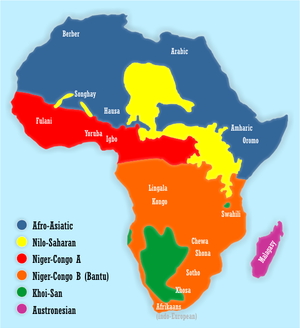Bantu languages
| Bantu | |
|---|---|
| Narrow Bantu | |
| Ethnicity: | Bantu peoples |
| Geographic distribution: |
Subsaharan Africa, mostly Southern Hemisphere |
| Linguistic classification: | Niger–Congo |
| Proto-language: | Proto-Bantu |
| Subdivisions: |
|
| ISO 639-2 / 5: | |
| Glottolog: | narr1281 |

Map showing the distribution of Bantu vs. other African languages. The Bantu area is in orange.
|
|
The Bantu languages (/ˈbæntuː/), technically the Narrow Bantu languages (as opposed to "Wide Bantu", a loosely defined categorization which includes other Bantoid languages), constitute a traditional branch of the Niger–Congo languages. There are about 250 Bantu languages by the criterion of mutual intelligibility, though the distinction between language and dialect is often unclear, and Ethnologue counts 535 languages. Bantu languages are spoken largely east and south of present-day Cameroon, that is, in the regions commonly known as Central Africa, Southeast Africa, and Southern Africa. Parts of the Bantu area include languages from other language families (see map).
The Bantu language with the largest total number of speakers is Swahili; however, the majority of its speakers know it as a second language. According to Ethnologue, there are over 180 million L2 (second-language) speakers, but only about 2 million native speakers.
According to Ethnologue, Shona is the most widely spoken as a first language, with 10.8 million speakers (or 14.2 million if Manyika and Ndau are included), followed closely by Zulu, with 10.3 million. Ethnologue separates the largely mutually intelligible Kinyarwanda and Kirundi, but, if grouped together, they have 12.4 million speakers.
...
Wikipedia
